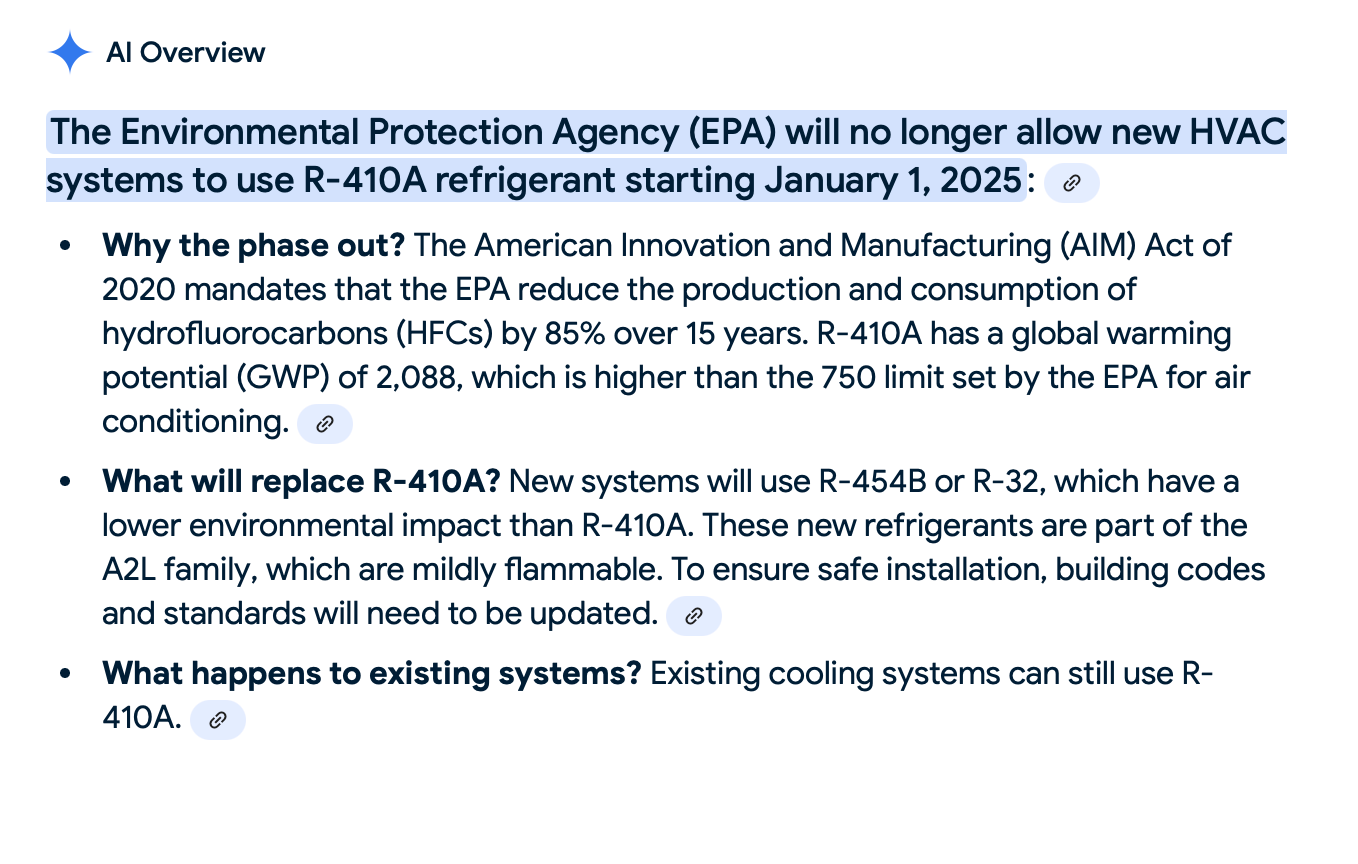
The Gov is here to "help" (again)
The Environmental Protection Agency (EPA) will no longer allow new HVAC systems to use R-410A refrigerant starting January 1, 2025:
Why the phase out? The American Innovation and Manufacturing (AIM) Act of 2020 mandates that the EPA reduce the production and consumption of hydrofluorocarbons (HFCs) by 85% over 15 years. R-410A has a global warming potential (GWP) of 2,088, which is higher than the 750 limit set by the EPA for air conditioning.
What will replace R-410A? New systems will use R-454B or R-32, which have a lower environmental impact than R-410A. These new refrigerants are part of the A2L family, which are mildly flammable. To ensure safe installation, building codes and standards will need to be updated.
What happens to existing systems? Existing cooling systems can still use R-410A.

As Always the Gov's good intentions are ment to help, but as in the past, it is coming with another price increase from the AC manufactures, Who are already bumping the cost of the new AC Equipment in more than $ 500.00 in many cases.
New Gov Regulations
Starting January 1, 2023, INSTALLATIONS of RESIDENTIAL STRAIGHT COOL SPLIT PRODUCT must meet the new SEER2 requirements. Inventory of existing residential straight cool split products must be sold and installed prior to this date.
The DOE has changed the testing procedure used to rate the efficiency of HVAC equipment to be more representative of installations in today’s homes. Equipment will now be rated according to SEER2. The DOE is also raising the minimum standards for efficiency for both straight cool and heat pump products. While it varies between equipment type, minimum efficiencies are increasing about 7-10% or 1 SEER point.
Cost is expected to go up as much as 28 %, for new equipments after January 1, 2023.
Distributors | Price Increase Notice
Dear Valued Customer;
As the industry continues to be challenged with increased costs for materials and supply chain, many of our manufacturers have announced price increases.
At this time we expect price increases in many of our product. As of October 1, 2022 we will be receiving and passing over a price increase on the following Brands: Rheem and Ruud 7-10 %
The "not keeping up issue."
No keeping up (EVERY SUMMER)
Every year as we get into summer, we receive [many] calls where the tenant reports: The temperature to be comfortable during the early mornings, but does go up little by little after midday, and the AC runs non-stop for hours “with-out keeping up”, many times above the “desire temperature” (e.g.; Tenants wants 74 but it is 76 or 77 in the house). When the techs gets to the house found “nothing wrong, with the AC” (all A/C Parameters “within aceptable range”).
This situation is VERY common and familiar to an AC tech, who sees between 7 and 10 houses per day (around 3000 properties per year), but is not as common for a tenant that has moved less than 10 times during their lifetime.
Why this happens ?
Generally this occur: in those properties where the AC COOLING CAPACITY is lower than the HEAT LAOD at any given moment.
Basically; the cooling capacity of an AC is “virtually constant”*, but the heat load may change during the day, as well as it does during the year. At some point Thermal balance breaks, there is more heat added into the house, while the “pumping [out] capacity” of the unit is about the same. When this “imbalance” takes place, the temperature in the house may go up a few degrees about “set point” (Desire temperature). The bigger the gap is [between the HL and the CP] the more the temperature will go up in the house.
Why it happens in some houses and not in others ?
Not every house is built equally: In the majority of cases the AC system has been designed and installed by a professional who takes into consideration all details, such as; the Heat Load (HL) during the entire year, the size of the property, ventilation, shade, construction type, house orientation, heat penetration, etc, while in some occasions part of these important details are overlooked by a less experience contractor. When the job is done properly, a good contractor has installed a system capable of maintain, at least 75 degrees of indoor temperature even when the outdoor temp is above 90 (but less than 95).
What is the solution ?
When the AC is proven to be working ok, with all the parameters within aceptable range, but still the thermal balance is broken with the unit struggling to keep up, the only practical option to consider [in many cases] is to increase the cooling capacity of the AC System by replacing the entire Equipment with a more capable machine, or adding a temporary window unit to increase the overall cooling capacity of the entire “house”.
Why is it so difficult to recommend a new unit in this case ?
Because in this case the AC is actually working, the only problem it has, is that at some point normally (around 3 months out of every year) the heat load is above its capacity.
.
